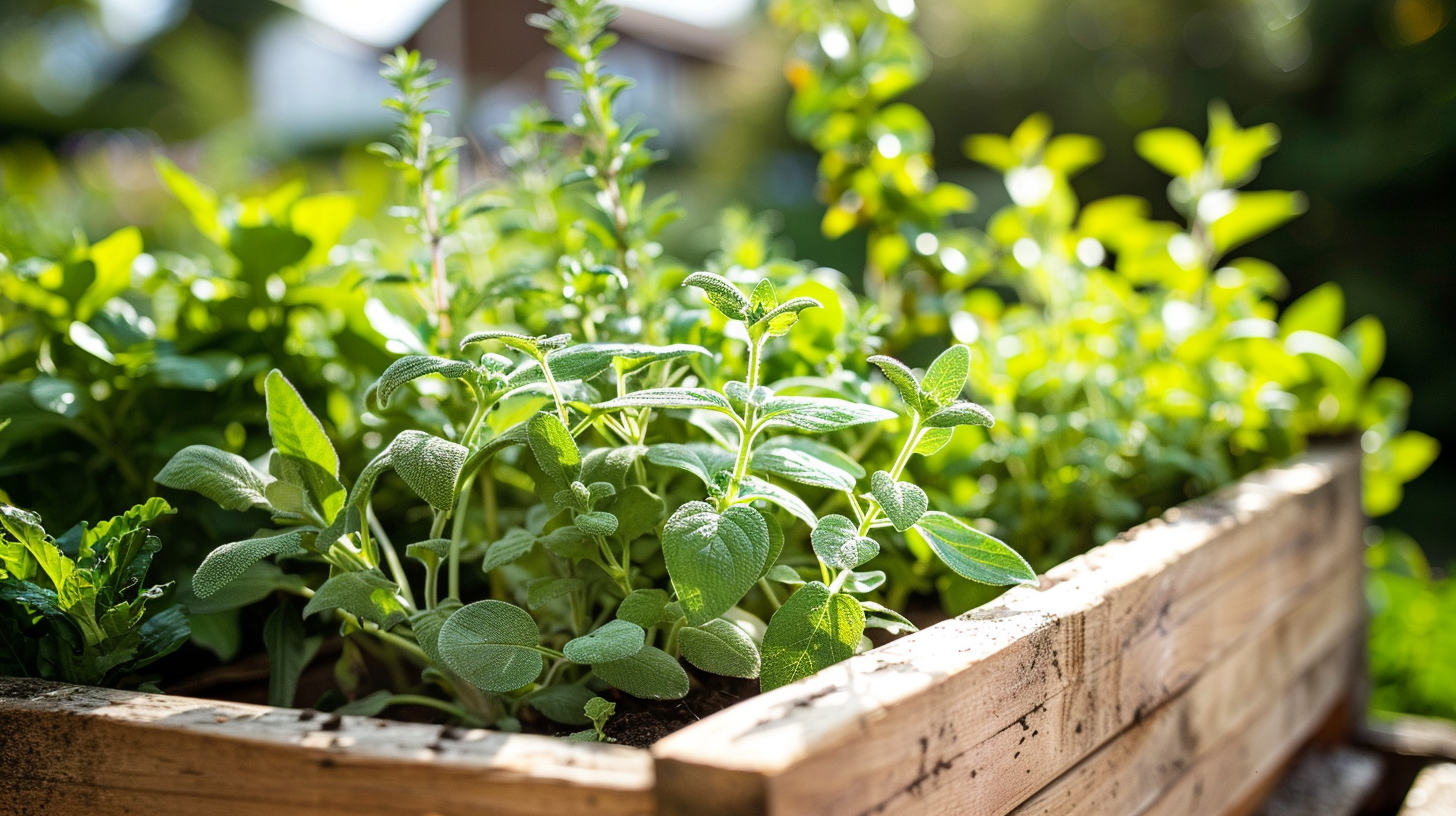Creating a herb garden can be a rewarding and enriching experience for both novice and experienced gardeners alike. In this article, we will provide you with essential tips and techniques to help you successfully establish and maintain your own herb garden. From selecting the right herbs and choosing the ideal location to managing pests and harvesting your herbs, we will guide you through every step of the process. Get ready to embark on a journey of cultivating fresh and flavorful herbs right in your own backyard.
Choosing the Right Herbs for Your Herb Garden
In order to ensure a successful herb garden, it is essential to carefully consider and select the appropriate herbs for your specific gardening needs. One important aspect to consider when choosing herbs for your garden is selecting companion plants. Companion plants are species that have a beneficial effect on each other when grown in close proximity. For instance, planting basil alongside tomatoes can help repel pests that commonly affect tomato plants. Additionally, choosing herbs that are known for their pest-repellent properties can help in managing herb garden pests. For example, planting mint or lavender can deter pests like aphids and mosquitoes. By strategically choosing companion plants and incorporating herbs with pest-repellent properties, you can create a balanced and thriving herb garden that is both visually appealing and functional.
Selecting the Ideal Location for Your Herb Garden
When selecting the ideal location for your herb garden, it is important to consider the sunlight requirements for your herbs, as different herbs have different needs. Additionally, the soil conditions and pH levels should be taken into account to ensure optimal growth. Lastly, protecting your herb garden from harsh elements such as strong winds or extreme temperatures is crucial for maintaining the health and vitality of your herbs.
Sunlight Requirements for Herbs
While considering the sunlight requirements for herbs, it is essential to find an optimal location that allows for the right amount of sunlight exposure. Maximizing growth in indoor herb gardening requires understanding the specific needs of each herb and providing the appropriate amount of sunlight. Most herbs require at least six to eight hours of direct sunlight daily to thrive. However, some herbs, such as basil and parsley, can tolerate partial shade. It is important to monitor the sunlight exposure and adjust accordingly to prevent overexposure or lack of sunlight. If natural sunlight is limited, supplementing with artificial grow lights can be beneficial. By carefully managing the sunlight requirements for herbs, indoor herb gardeners can create an optimal growing environment and ensure healthy and thriving plants.
Soil Conditions and Ph
To ensure the success of your herb garden, it is crucial to assess the soil conditions and pH levels, as well as select the ideal location for optimal growth. One important step in this process is soil testing. By conducting a soil test, you can determine the nutrient levels present in the soil and identify any deficiencies or imbalances that may hinder herb growth. Soil testing also helps in adjusting pH levels, as different herbs have different pH requirements. Many herbs prefer slightly acidic soil, with a pH range of 6.0 to 7.0. If the soil pH is too high or too low, adjusting it can be done using organic amendments such as lime or sulfur. By understanding and addressing the soil conditions and pH levels, you can create an ideal environment for your herb garden and promote healthy growth.
Protection From Harsh Elements
Selecting an appropriate location with sufficient shade and effective wind barriers is essential to provide the necessary protection from harsh elements for your herb garden. When it comes to protecting your herbs, there are various methods you can employ. One popular option is building a greenhouse. Greenhouses offer a controlled environment where you can regulate temperature, humidity, and sunlight exposure. This helps protect your herbs from extreme weather conditions such as frost, excessive heat, or strong winds. Additionally, greenhouses provide a sheltered space that keeps pests and animals at bay, reducing the risk of damage to your plants. If building a greenhouse is not feasible, you can utilize other protection methods such as using row covers, cloches, or shade cloth. These options provide a temporary shield against harsh elements and can be easily installed and removed as needed. Overall, ensuring proper protection for your herb garden is crucial for its successful growth and longevity.
Preparing the Soil for Your Herb Garden
When it comes to preparing the soil for your herb garden, there are two important factors to consider: soil pH and nutrient requirements. Herbs thrive in slightly acidic to neutral soil, so it’s crucial to test and adjust the pH if necessary. Additionally, herbs have specific nutrient needs, so enriching the soil with organic matter or compost can provide them with the necessary nutrients for healthy growth.
Soil Ph and Herbs
The article discusses the importance of maintaining the appropriate soil pH levels for optimal growth of various herbs in your garden. Adjusting pH levels in the soil is crucial since different herbs have different pH preferences. The first step in ensuring the right pH is to test the soil. This can be done using a soil testing kit or by sending a soil sample to a laboratory. Once the pH is determined, adjustments can be made by adding amendments such as lime to raise the pH or sulfur to lower it. Most herbs prefer a slightly acidic to neutral pH, around 6 to 7. Maintaining the correct pH level ensures that herbs can absorb nutrients effectively, promoting healthy growth and maximizing the flavor and aroma of the herbs in your garden.
Nutrient Requirements for Herbs
An understanding of the nutrient requirements for herbs is essential for preparing the soil in your herb garden. Herb garden maintenance involves providing the right balance of nutrients to ensure healthy growth and abundant harvests. When it comes to fertilizers, you have the choice between organic and non-organic options. Organic fertilizers are derived from natural sources such as compost, manure, and bone meal. They provide slow-release nutrients and improve soil structure over time. Non-organic fertilizers, on the other hand, are synthetic products that provide a quick nutrient boost to plants. While both types of fertilizers can be effective, organic fertilizers are often favored for herb gardens due to their environmentally friendly nature. They promote soil health and microbial activity, resulting in healthier plants and better-tasting herbs. Ultimately, the choice between organic and non-organic fertilizers depends on personal preference and the specific needs of your herb garden.
Planting Your Herb Garden: Tips and Tricks
To ensure successful growth and cultivation of your herb garden, implementing essential tips and tricks for planting is crucial. Whether you have limited space or just want to add some greenery to your home, container gardening and vertical gardening are great options to consider. Container gardening allows you to grow herbs in pots or other containers, making it easier to manage and maintain. This method is particularly useful if you have limited space or if you want to move your herbs around to find the best growing conditions. On the other hand, vertical gardening involves growing herbs on walls or other vertical surfaces, maximizing your space and creating an eye-catching display. By utilizing these techniques, you can create a beautiful and functional herb garden, even in small or unconventional spaces.
Watering and Fertilizing Your Herb Garden
Properly watering and fertilizing your herb garden is essential for maintaining healthy and thriving plants. Herb garden maintenance requires careful attention to the needs of each individual herb, as different herbs have different watering and fertilizing requirements. When it comes to fertilizers, organic options are the best choice for herbs. Organic fertilizers for herbs provide essential nutrients without the use of synthetic chemicals, ensuring that your herbs are safe for consumption and free from harmful residues. These fertilizers, derived from natural sources such as compost, manure, or bone meal, provide a slow release of nutrients to the plants, promoting steady growth and enhancing flavor. Additionally, organic fertilizers help to improve soil health and maintain a balanced ecosystem, benefitting both your herb garden and the environment. So, make sure to choose organic fertilizers for your herb garden maintenance to achieve healthy and flavorful herbs.
Managing Pests and Diseases in Your Herb Garden
Implementing regular inspections and promptly addressing any signs of pests or diseases is crucial for effectively managing and preserving the health of your herb garden. Pests and diseases can quickly spread and damage your herbs, leading to a decrease in yield and quality. To address this issue, many gardeners are turning to natural remedies and organic pest control methods. These methods involve using natural substances such as neem oil, garlic, or insecticidal soap to repel or kill pests. Additionally, companion planting can be used to deter pests by interplanting herbs that repel specific insects. It is important to research and identify common pests and diseases that affect herbs in your region and take proactive measures to prevent their occurrence. By incorporating natural remedies and organic pest control methods, you can effectively manage pests and diseases while maintaining the health and vitality of your herb garden.
Pruning and Harvesting Your Herb Garden
Regular pruning and timely harvesting are essential practices for maintaining the optimal growth and productivity of your herb garden. Pruning techniques play a crucial role in shaping the growth of your herbs, ensuring they remain healthy and vibrant. By removing dead or damaged branches, you encourage new growth and prevent the spread of diseases. When pruning, it is important to use sharp, clean tools to make precise cuts and avoid unnecessary damage. Additionally, proper harvesting techniques are crucial for preserving the flavor and quality of your herbs. Harvesting at the right time, usually during the morning when the essential oils are most concentrated, prevents the herbs from losing their potency. To preserve the harvested herbs, you can dry them by hanging them upside down in a cool, dark place or store them in airtight containers.
Enhancing Your Herb Garden With Decorative Elements
Incorporating various decorative elements, such as sculptures or colorful planters, can add a touch of charm and personality to your herb garden, transforming it into a visually appealing and inviting space. Using decorative containers for your herb garden is a great way to showcase your creativity and enhance the overall design. These containers come in a variety of shapes, sizes, and materials, allowing you to choose ones that complement your herb selection and garden theme. Artistic elements, such as sculptures or garden art, can also be incorporated into your herb garden design to create a unique and eye-catching focal point. These elements not only add visual interest but also create a sense of harmony and balance in your garden. By incorporating decorative elements, you can turn your herb garden into a beautiful and inspiring oasis.




